Cold Email That Gets Responses in 2025: The Ultimate Freelancer Playbook
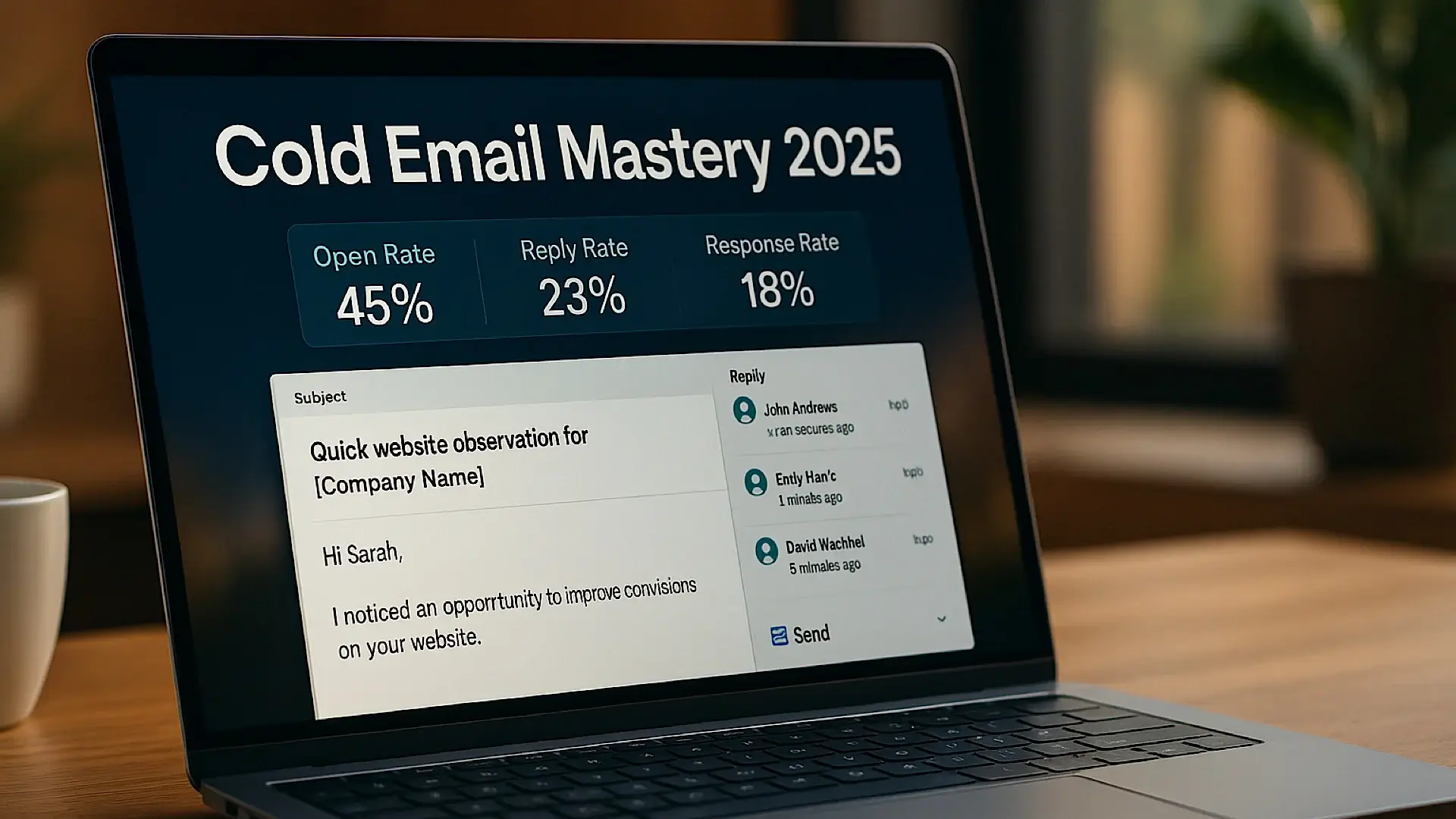
Introduction: The Cold Email Myth vs Reality
Want to send cold emails that actually get responses in 2025?
You’re not alone—most freelancers struggle to get replies from their outreach. In fact, industry data shows that cold email that gets responses 2025 averages just a 1–5% reply rate. That means for every 100 emails, you’re lucky to get five responses—and even fewer paying clients.
So why does most outreach fail? Because freelancers treat cold emailing like a numbers game instead of a relationship-building strategy. They send out generic “I can help you” templates to dozens of prospects, and wonder why no one bites.
The real secret? Positioning yourself as a trusted expert before you even hit send. A strong personal brand that attracts clients can boost your reply rate dramatically—making cold outreach feel almost warm.
In this guide, you’ll learn exactly how to craft a cold email that gets responses in 2025:
– How to write subject lines that get opened
– How to personalize without sounding fake
– The tech setup you need to avoid the spam folder
– And how to use proven templates that get replies
Want the bigger picture? Check out our guide on how to attract high-paying clients in 2025 for more strategies that go beyond the inbox.
Let’s dive into the cold email system that works in 2025—whether you’re a designer, developer, copywriter, or coach.
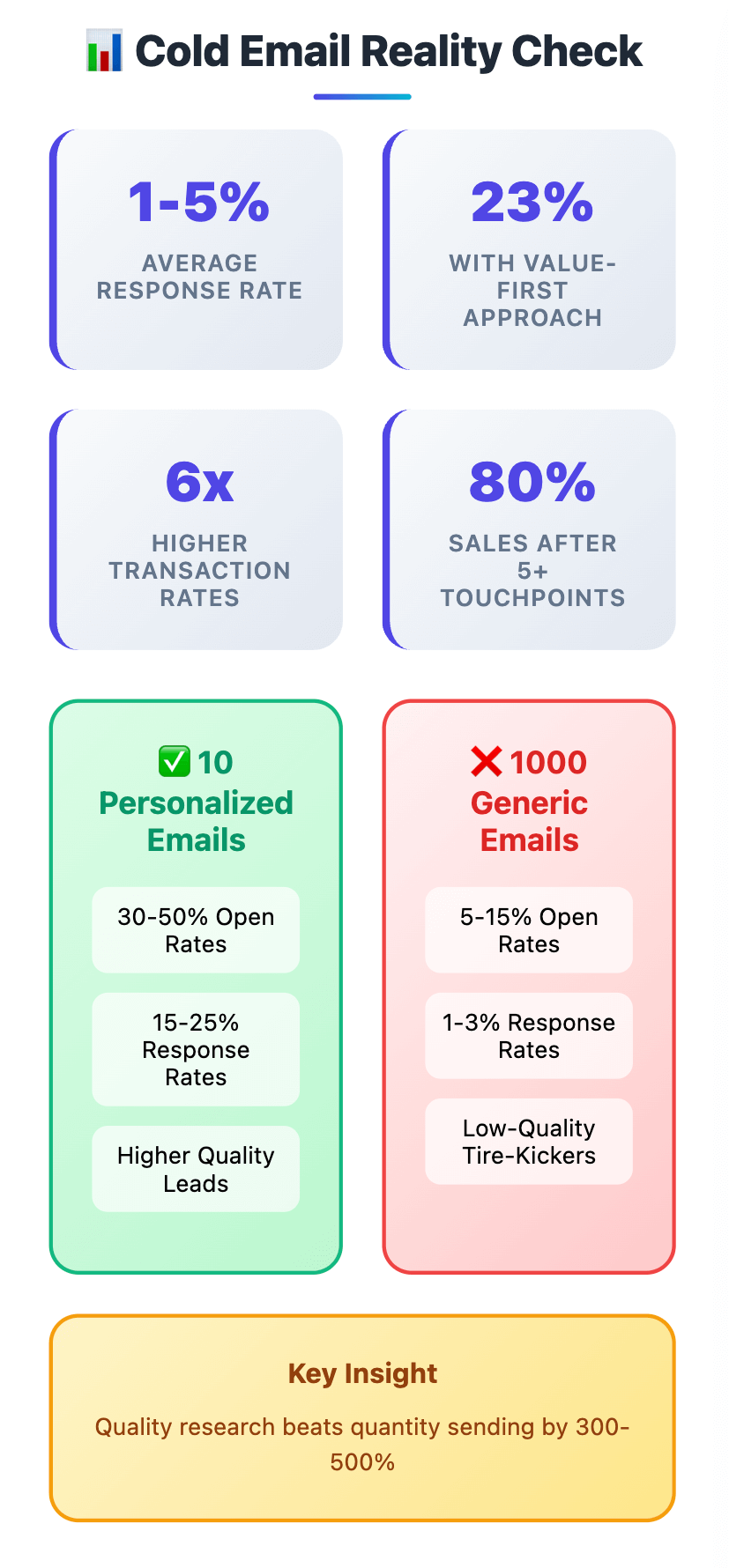
The Psychology Behind Cold Email: What Makes a Freelancer Outreach Strategy Work?
Understanding Perception Barriers
Every prospect faces three major barriers when they see your email:
The Spam Filter (Mental & Technical): Their brain immediately categorizes unknown senders as potential threats or time-wasters. Technically, email providers are getting stricter about bulk sending.
Time Scarcity: Decision-makers receive 50-200 emails daily. Your message competes with urgent internal communications, vendor updates, and personal emails.
Skepticism Shield: They’ve been burned by overpromising freelancers, scammy agencies, and pushy salespeople. Default mode: delete first, ask questions never.
The Personalization Trust Factor
Campaign Monitor’s infographic shows that personalized emails deliver 6× higher transaction rates and significantly boost engagement across industries.. But personalization isn’t just using their first name—it’s about showing real understanding of their specific situation, challenges, and goals, especially if you’re using a personalized email template for freelancers in a cold outreach context.
Effective personalization includes:
- Reference to recent company news or achievements
- Specific observation about their website, content, or products
- Connection to mutual contacts or shared experiences
- Industry-specific insights that show expertise
Reciprocity and Attention Mechanisms
The principle of reciprocity suggests people feel obligated to return favors. In cold email, especially when following a smart cold email outreach strategy, this means leading with value before asking for anything.. Examples include:
- Sharing a relevant industry insight
- Pointing out a website optimization opportunity
- Offering a free resource that solves an immediate problem
- Making a valuable introduction
Case Study: Sarah, a conversion copywriter, increased her response rate from 3% to 23% by leading each email with a specific CRO insight about the prospect’s landing page. Instead of asking for work, she provided immediate value that demonstrated her expertise.
↑ Back to Table of ContentsStrategic Preparation: Before You Write a Single Email
Defining Your Ideal Client Profile (ICP)
Most freelancers cast too wide a net—especially those just getting started. If you’re new, this guide on freelancer outreach for beginners shows exactly how to start freelancing without experience in 2025 and build meaningful client relationships from day one.
Your ICP should include:
- Industry: SaaS startups, e-commerce brands, professional services
- Company size: 10-100 employees, $1M-10M revenue
- Role: Marketing Director, Founder, VP of Sales
- Pain points: Struggling with lead generation, outdated website, poor email performance
- Budget indicators: Recent funding, job postings for marketing roles, using premium tools
Building Your Prospect List
Quality beats quantity every time. It’s better to send 10 highly researched, personalized emails using a cold email that gets responses 2025 approach than blasting out 1,000 generic templates that never get noticed.
Top prospecting sources:
- LinkedIn Sales Navigator: Filter by industry, company size, job title
- Apollo.io: Comprehensive database with email verification
- Crunchbase: Great for funded startups and growth companies
- Manual research: Company websites, team pages, recent press releases
Research checklist for each prospect:
- Recent company news or achievements
- Personal information (LinkedIn posts, company blog articles)
- Current tools they’re using (BuiltWith, Wappalyzer)
- Competitors and industry trends
- Mutual connections or shared interests
The 10 vs 1000 Rule
Here’s why personalized email template strategies outperform mass blasts:
10 Personalized Emails:
- 2-3 hours research and writing time
- 30-50% open rates
- 15-25% response rates
- Higher quality conversations
- Better client fit and project success
1000 Generic Emails:
- Same 2-3 hours using templates
- 5-15% open rates
- 1-3% response rates
- Low-quality leads and tire-kickers
- Higher unsubscribe and spam rates
📧 Writing cold emails that get replies isn’t guesswork — it’s structure. Here’s the proven 7-step framework top freelancers use to get responses in 2025.
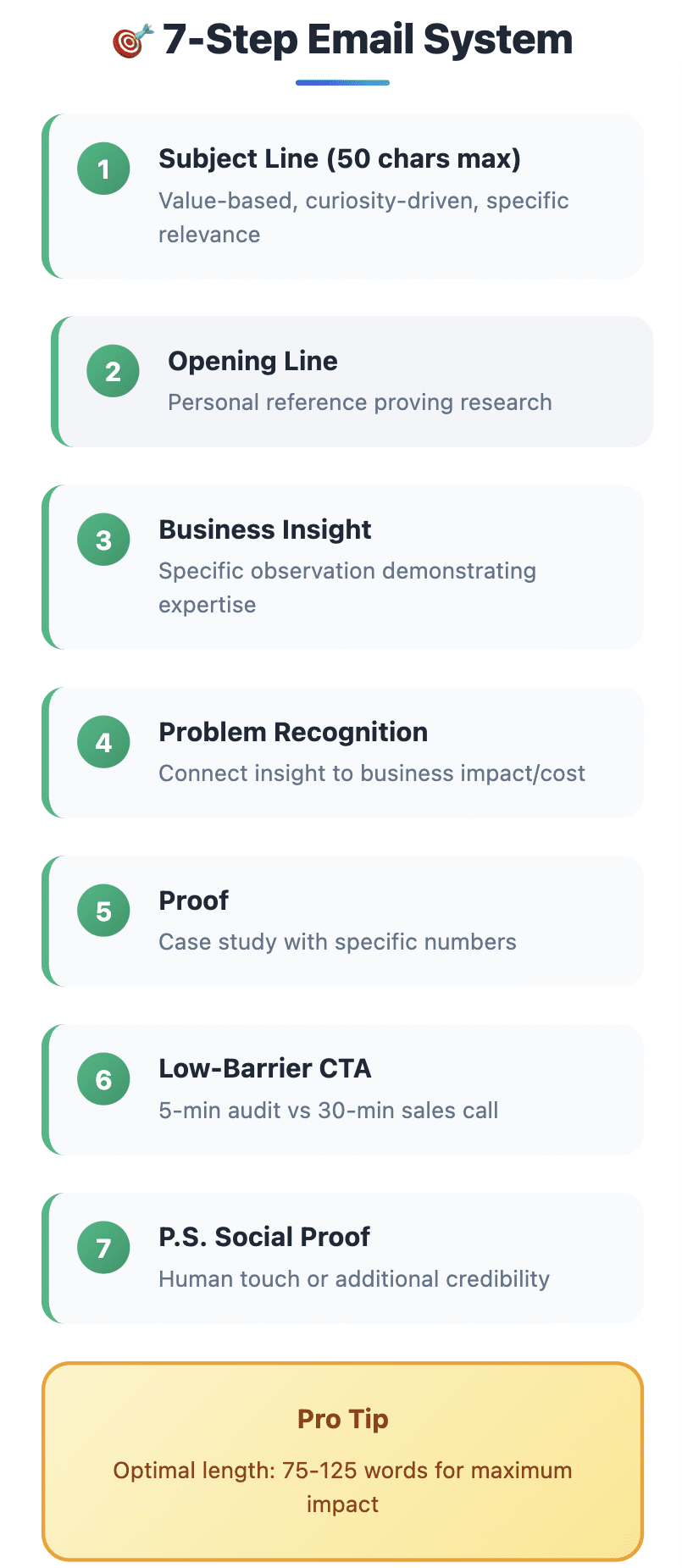
The 7-Step System for Effective Cold Emails
Step 1: Subject Line (50 Characters Max)
Winning subject line formulas:
Your subject line determines if your email gets opened. Focus on value, curiosity, or specific relevance—never generic phrases like “Quick question” or “Partnership opportunity” if you want to write a cold email that gets responses 2025.
- Value-based: “3 ways to improve [specific metric]”
- Question-based: “Is [specific challenge] still a priority?”
- Observation-based: “Noticed your recent [achievement/change]”
- Curiosity-based: “[Industry] insight you might find useful”
Examples:
- “5-min website audit for GreenTech Solutions”
- “Your blog traffic strategy question”
- “Congrats on the TechCrunch feature”
Step 2: Opening Line (Personal + Reference)
The first sentence should prove you’ve done your homework. Reference something specific about them, their company, or their industry.
Bad: “I hope this email finds you well.” Good: “Saw your post about the challenges of scaling content production—I’ve helped three similar SaaS companies solve this exact problem.”
Step 3: Specific Business Insight
Share an observation about their business that demonstrates expertise. This isn’t generic advice—it’s specific to their situation.
Example: “I noticed your checkout page has a 40% abandon rate (higher than the 28% industry average). Usually, this happens when the form asks for too much information upfront.”
Step 4: Problem Recognition
Connect your insight to a broader business impact. Help them see the cost of not addressing the issue.
Example: “For a company processing $50K monthly, that extra 12% abandonment likely costs $6K in lost revenue each month.”
Step 5: Proof (Case Study or Specific Result)
Provide credible evidence that you can solve their problem. If you’re aiming for a cold email that gets responses 2025, you’ll want to include specific numbers, real-world client results, and a solid freelancer website or portfolio that builds instant trust.
Example: “I recently helped CloudSync (another project management SaaS) reduce checkout abandonment from 38% to 22% by simplifying their form flow—added $84K to their quarterly revenue.”
Step 6: Low-Barrier Call-to-Action
Don’t ask for a 30-minute sales call. Request something easy that provides mutual value.
High-barrier: “Let’s schedule a call to discuss your marketing strategy.” Low-barrier: “Would a 5-minute checkout audit be useful? I could screen-record the main issues and send it over—no strings attached.”
Step 7: P.S. with Social Proof or Human Touch
The P.S. is often the most-read part of an email. Use it for social proof, a human connection, or additional value—especially when building a personal brand that attracts clients and makes your outreach feel more authentic.
Examples:
- “P.S. Just helped another client in your space increase conversions by 34%. Happy to share the case study if it’s relevant.”
- “P.S. Love what you’re doing with sustainable packaging—my daughter’s generation will thank companies like yours.”
Proven Cold Email Templates with Real Results
Template 1: “The Opportunity Spotter”
Use when: You’ve identified a specific improvement opportunity Response rate: 18-25% (tested across 500+ emails)
Subject: Quick [website/process] observation for [Company]
Hi [Name],
Noticed you’re expanding into the European market (congrats on the Amsterdam office!).
I was looking at your pricing page and spotted something that might be costing you conversions with international visitors—the pricing is only shown in USD, and there’s no local payment methods for EU customers.
I recently helped TechFlow (similar B2B SaaS) add multi-currency and local payment options—part of a cold email that gets responses 2025 approach focused on showing value upfront. They saw a 31% increase in EU conversions within 60 days.
Would a 5-minute audit of your international user experience be helpful? I could record the main friction points and send it over—no strings attached.
Best, [Your name]
P.S. The Amsterdam office looks amazing in your LinkedIn photos. Great choice on the location!
Template 2: “The Insight Sharer”
Use when: You have industry knowledge they’d find valuable Response rate: 15-22%
Subject: [Industry] insight you might find useful
Hi [Name],
Your recent blog post about [specific topic] resonated with my experience working with [similar companies].
I’ve noticed an interesting pattern with [industry] companies: those that implement [specific strategy] typically see [specific outcome], while those that don’t often struggle with [specific challenge].
Just helped [Similar Company] implement this approach—they went from [before state] to [after state] in [timeframe].
Thought you might find the case study interesting. Would it be worth sharing?
Best, [Your name]
P.S. Really enjoyed your perspective on [specific point from their content]. Hadn’t considered that angle before.
Template 3: “The Connection Builder”
Use when: You have mutual connections or shared experiences
Response rate: 20-28%
Subject: [Mutual connection] suggested I reach out
Hi [Name],
[Mutual connection] mentioned you’re working on [specific project] and thought we should connect.
I’m [brief credentials] and recently helped [mutual connection’s company] with [similar challenge]. We achieved [specific result] which directly contributed to [broader business impact].
[Mutual connection] thought my experience with [specific area] might be relevant to what you’re building at [Company].
Would a brief conversation be worthwhile? Happy to share what worked (and what didn’t) in similar situations.
Best, [Your name]
P.S. [Mutual connection] speaks highly of your work on [specific project]. Looking forward to learning more about it.
↑ Back to Table of Contents
Building an Effective Follow-Up Sequence
A cold email follow-up sequence is crucial because 80% of sales happen after 5+ touchpoints, but 44% of salespeople give up after just one follow-up.
The 4-Touch Follow-Up System
Here’s a breakdown of the full 4-touch cold email follow-up system with exact timing, focus, and purpose at each step.
| Timing | Focus | Goal | |
|---|---|---|---|
| Initial | Day 0 | Value + Insight | Get response or permission to follow up |
| Follow-up #1 | Day 3 | Additional value or different angle | Reiterate interest, provide more value |
| Follow-up #2 | Day 7 | Social proof or case study | Build credibility and urgency |
| Follow-up #3 | Day 21 | Permission-based breakup | Final attempt with graceful exit option |
📬 Most freelancers give up too early — but follow-ups are where deals are made. Here’s the proven 4-touch system that keeps your outreach professional, persistent, and value-driven.
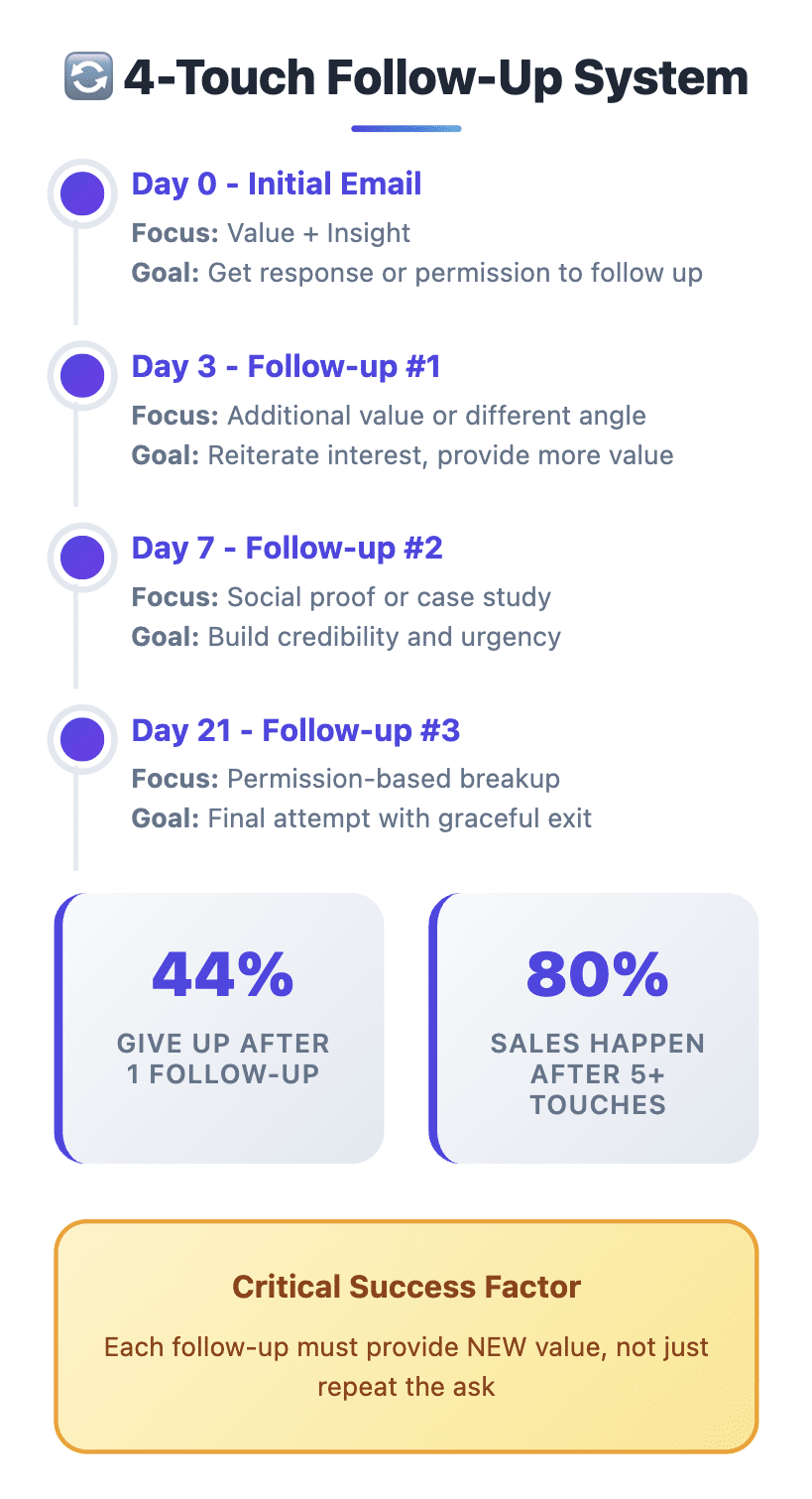
Follow-Up Email Examples
Follow-up #1 (Day 3):
Subject: Re: [Original subject]
Hi [Name],
Following up on my previous email about [specific topic].
I came across this case study that might be relevant: [Similar company] implemented [strategy] and saw [result]. The approach might work well for [their specific situation].
Worth a quick chat to explore if this applies to [Company]?
Best,
[Your name]
Follow-up #2 (Day 7):
Subject: [Specific result] in [timeframe] - case study
Hi [Name],
Not sure if you saw my previous emails, but wanted to share a relevant success story.
[Client name] in [similar industry] was struggling with [problem]. We implemented [solution] and achieved [specific result] in [timeframe].
The strategy might apply to [their specific challenge mentioned in research].
Would a 10-minute case study walkthrough be valuable?
Best,
[Your name]
Follow-up #3 (Day 21):
Subject: Permission to stay in touch?
Hi [Name],
I know you're busy, so this will be my last email about [topic].
I'm still convinced there's opportunity to [specific benefit] at [Company], but I understand timing might not be right.
Should I circle back in Q2, or would you prefer I don't follow up again?
Best,
[Your name]
P.S. Always open to connecting on LinkedIn if that's easier for future opportunities.
Technical Setup: Deliverability and Email Infrastructure
Poor deliverability kills even the best cold email that gets responses 2025 campaigns. No matter how good your copy is, if your emails land in spam, your whole cold email outreach strategy breaks down.
Essential DNS Records
SPF (Sender Policy Framework):
v=spf1 include:_spf.google.com ~all
Learn more about SPF and DKIM records in Google’s official documentation for ensuring inbox delivery.
DKIM (DomainKeys Identified Mail): Generated by your email provider (Gmail, Outlook, or cold email tool)
DMARC (Domain-based Message Authentication):
v=DMARC1; p=quarantine; ruf=mailto:admin@yourdomain.com
Domain Warming Process
Week 1: Send 5-10 emails per day to engaged contacts (friends, colleagues) Week 2: Increase to 15-20 emails per day, mix of warm and cold Week 3: Ramp up to full volume (50-100 per day maximum)
Pro tip: Use a subdomain for cold outreach (outreach.yourdomain.com) to protect your main domain reputation.
Avoiding Spam Triggers
Words to avoid:
- “Free,” “Guarantee,” “Limited time”
- “Make money,” “Increase sales,” “Grow your business”
- Multiple exclamation points or ALL CAPS
- Excessive links (more than 2 in initial emails)
Best practices:
- Plain text emails outperform HTML for cold outreach
- Keep images minimal or avoid entirely
- Maintain a text-to-image ratio of 80:20
- Use a professional email signature with contact info
A/B Testing: How to Improve Cold Email Open Rates and Optimize Performance
📈 Before you start optimizing, make sure you’re tracking the right metrics and avoiding the most common mistakes. Here’s a visual snapshot of what works—and what doesn’t.
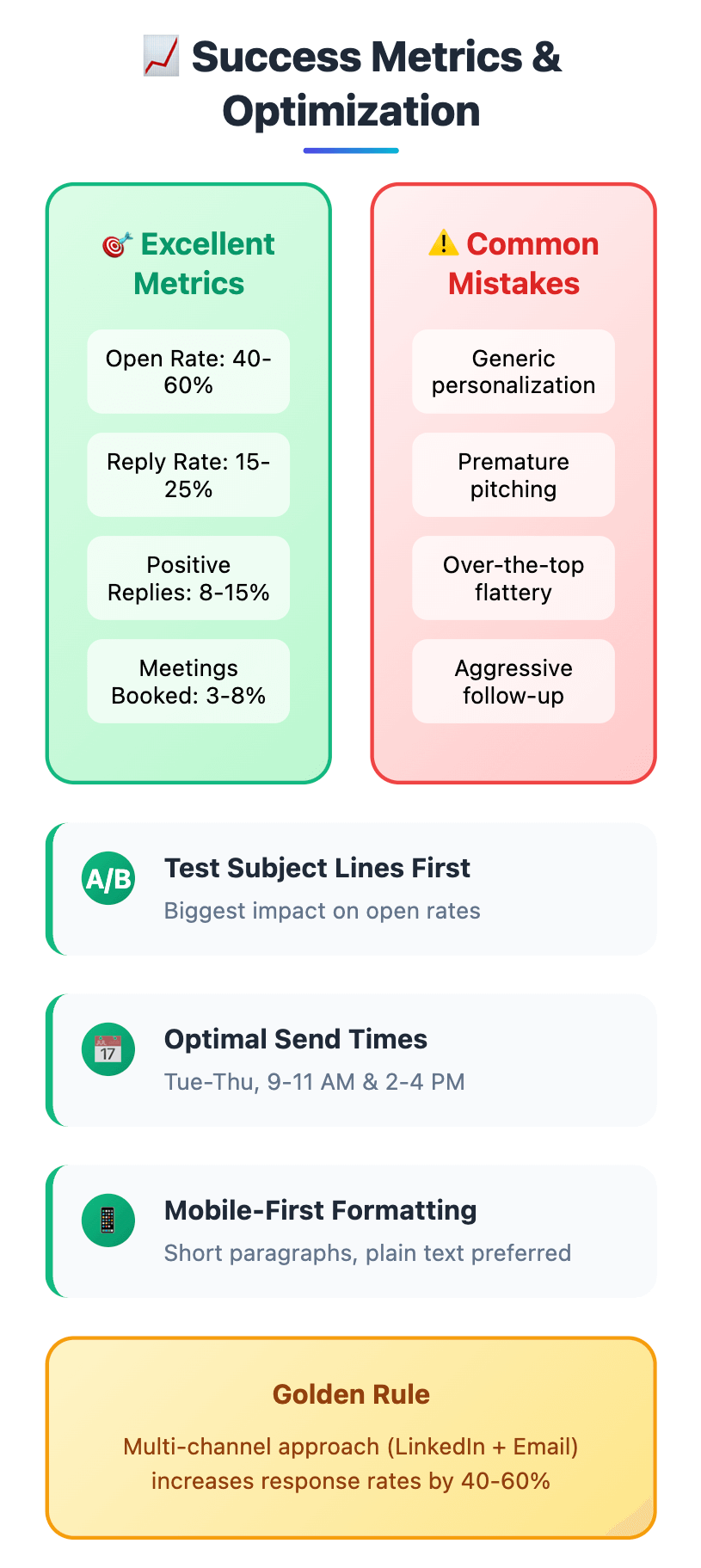
Successful freelancer outreach requires continuous optimization. If you’re building a cold email that gets responses 2025, you need to test one element at a time to understand exactly what impacts open and reply rates.
What to Test
Subject Lines (Biggest Impact):
- Length: Short (20-30 chars) vs Medium (30-40 chars)
- Style: Question vs Statement vs Value proposition
- Personalization: Company name vs recipient name vs no personalization
Email Length:
- Short (under 100 words) vs Medium (100-150 words) vs Long (150+ words)
Call-to-Action:
- High commitment (30-min call) vs Low commitment (5-min audit)
- Question format vs Statement format
- Specific time (Tuesday 2 PM) vs Flexible (this week)
Send Timing:
- Day of week (Tuesday-Thursday typically best)
- Time of day (9-11 AM and 2-4 PM often optimal)
- Avoid Mondays (catch-up day) and Fridays (wind-down)
Measuring Success
Key Metrics:
- Open Rate: 40-60% is excellent for cold email
- Reply Rate: 15-25% indicates strong targeting and messaging
- Positive Reply Rate: 8-15% shows message-market fit
- Meeting Booked Rate: 3-8% is typical for B2B freelance services
Tools for Tracking:
- Mailtrack: Simple Gmail tracking extension
- Yesware: Advanced analytics and templates
- Instantly: Full cold email automation platform
- Superhuman: Premium email client with built-in tracking
Testing Framework
Week 1: Establish baseline with current approach (50 emails) Week 2: Test new subject line format (50 emails) Week 3: Test winning subject line + new email structure (50 emails) Week 4: Test winning combination + new CTA (50 emails)
Document results in a simple spreadsheet:
| Test | Emails Sent | Open Rate | Reply Rate | Positive Replies | Winner |
|---|---|---|---|---|---|
| Baseline | 50 | 22% | 8% | 4% | – |
| Subject A | 50 | 34% | 12% | 6% | ✓ |
| Subject A + Structure B | 50 | 36% | 18% | 9% | ✓ |
Integrating Cold Email into Your Client Acquisition Ecosystem
Cold email that gets responses 2025 works best as part of a multi-channel approach, not a standalone strategy.
LinkedIn + Email Combination
The 3-Touch Sequence:
- LinkedIn: Connect with personalized note
- LinkedIn: Engage with their content (like, comment meaningfully)
- Email: Reference LinkedIn interaction and provide value
This approach increases response rates by 40-60% compared to cold email alone.
SEO Integration for Link Building
Position yourself as a helpful resource while building domain authority:
“Broken Link” Cold Email: “Hi [Name], love your article on [topic]. Noticed one of your links to [resource] is broken. I actually wrote a comprehensive guide on [same topic] that might be a good replacement: [your link]. Happy to suggest other resources if that one doesn’t fit!”
“Resource Page” Outreach: “Hi [Name], found your [specific resource page] really helpful. I recently published [relevant resource] that your audience might find valuable for [specific use case]. Worth considering for the page?”
Retargeting Integration
Cookie-Based Follow-Up:
- Prospect visits your website after email
- Automatically trigger personalized follow-up: “Saw you checked out our [specific page]. Did you find what you were looking for?”
- Provide relevant case studies or resources based on pages visited
Tools like Instantly and Lemlist offer website tracking integration for this approach.
↑ Back to Table of ContentsCommon Mistakes and How to Avoid Them
Mistake 1: Generic Personalization
Wrong: “Hi [Name], I love what [Company] is doing!” Right: “Hi Sarah, your approach to sustainable packaging at EcoBox really resonates—especially the biodegradable mailer innovation.”
Mistake 2: Premature Pitching
Wrong: Leading with your services and pricing Right: Leading with insights about their business and industry trends
Mistake 3: Over-the-Top Flattery
Wrong: “Your company is absolutely amazing and revolutionary!” Right: “Your Q3 growth numbers are impressive—57% year-over-year in a challenging market.”
Mistake 4: Link-Heavy First Emails
Wrong: Including portfolio links, case study links, calendar links, and website links Right: Maximum 1 link, preferably to something valuable for them (not about you)
Mistake 5: Aggressive Follow-Up
Wrong: Following up every day with increasingly desperate messages Right: Spaced follow-ups (3-7-21 day intervals) with new value each time
↑ Back to Table of ContentsFrequently Asked Questions
How long should a cold email be?
Optimal length: 75-125 words. Long enough to provide value and context, short enough to respect their time. Mobile-first formatting means shorter paragraphs (1-2 sentences max) work best.
What tone should I use—formal or friendly?
Match their company culture. B2B tech startups often prefer casual, friendly tones. Traditional industries (law, finance, healthcare) may prefer more formal approaches. Check their website copy and social media for tone cues.
Should I send from my personal domain or agency domain?
Personal domains typically perform better for freelancer outreach. They feel more authentic and less “sales-y.” Use firstname@yourdomain.com rather than info@ or hello@ addresses.
What if I don’t get a response after 4 emails?
Respect the silence. Four touchpoints over 3-4 weeks is sufficient. Add them to a quarterly “check-in” list for future opportunities. Sometimes timing just isn’t right, but situations change.
How do I personalize when there’s limited information available?
Focus on company-level insights:
- Recent press releases or blog posts
- Industry trends affecting their business
- Competitors they’re likely watching
- Tools they’re using (check their job postings)
- General challenges in their industry/role
Use tools like Builtwith to see their tech stack, SimilarWeb for traffic insights, or Crunchbase for funding and growth information.
↑ Back to Table of ContentsYour 30-Day Cold Email Power Plan
Week 1: Strategy and Foundation
- Day 1-2: Define your ideal client profile and value proposition
- Day 3-4: Set up technical infrastructure (SPF, DKIM, DMARC)
- Day 5-7: Build prospect list (50-100 high-quality prospects)
Week 2: Template Creation and Setup
- Day 8-10: Write 3 email templates using the 7-step system to build a solid cold email that gets responses 2025 foundation.
- Day 11-12: Set up tracking and email tools
- Day 13-14: Create follow-up sequence templates
Week 3: First Campaign Launch
- Day 15: Send first batch (10 emails) to test deliverability
- Day 16-18: Send 15-20 emails daily to build sending reputation
- Day 19-21: Launch follow-up sequence for non-responders
Week 4: Optimization and Scaling
- Day 22-24: Analyze results and identify improvement opportunities
- Day 25-26: A/B test subject lines or email structure
- Day 27-28: Scale successful approaches to full prospect list
Success Metrics to Track:
- Open rates above 35%
- Reply rates above 12%
- Positive response rates above 6%
- At least 2-3 qualified conversations booked
Conclusion: Your Path to Cold Email Success
Mastering cold email that gets responses 2025 isn’t about sending more messages into the void — it’s about building a repeatable, data-driven system that earns attention and builds trust. Whether you’re a designer, developer, copywriter, or consultant, these strategies will help you shift from “hoping someone replies” to consistently landing quality clients.
🔑 Key Takeaways:
- ✅ Quality research beats quantity sending every time.
- ✅ A personalized email template for freelancers outperforms generic blasts by 300–500%.
- ✅ Technical setup (SPF, DKIM, DMARC) and warm-up systems protect deliverability.
- ✅ A smart cold email outreach strategy turns a single email into a full conversion journey.
- ✅ Learning how to improve cold email open rates starts with magnetic subject lines and continues with message relevance.
The difference between freelancers who struggle to get responses and those with full calendars often comes down to systems, not talent. Cold email mastery is the great equalizer — and in 2025, it’s your most scalable skill.
🎯 Ready to take action?
Join the FreelanceBoosters Telegram channel for advanced templates, real-world breakdowns, and exclusive Q&A with freelancers who’ve turned cold outreach into a predictable growth engine.
Continue Your Learning Journey: Internal Resources That Expand This Guide
Here are related guides that help you level up each stage of your cold email workflow:
👉 The Ultimate Guide to Building a Freelance Portfolio That Attracts Clients
👉 How to Attract High-Paying Clients in 2025
👉 How to Create a Personal Brand That Attracts Clients
👉 Freelancer Website vs Portfolio: Which One Do You Really Need?
